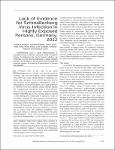Lack of Evidence for Schmallenberg Virus Infection in Highly Exposed Persons, Germany, 2012
Ducomble, Tanja
Wilking, Hendrik
Stark, Klaus
Takla, Anja
Askar, Mona
Schaade, Lars
Nitsche, Andreas
Kurth, Andreas
Schmallenberg virus, a novel orthobunyavirus, is spreading among ruminants, especially sheep, throughout Europe. To determine the risk for human infection, we conducted a survey among shepherds to assess possible exposure and symptoms. We also performed serologic and molecular assays. No evidence of transmission to humans was detected.
Dateien zu dieser Publikation
Keine Lizenzangabe
Verwandte Publikationen
Anzeige der Publikationen mit ähnlichem Titel, Autor, Urheber und Thema.
-
2008-09-11ZeitschriftenartikelCharacterization of attaching and effacing Escherichia coli (AEEC) isolated from pigs and sheep Fröhlicher, Erik; Krause, Gladys; Zweifel, Claudio; Beutin, Lothar; Stephan, RogerBackground: Attaching and effacing Escherichia coli (AEEC) are characterized by their ability to cause attaching-and-effacing (A/E) lesions in the gut mucosa of human and animal hosts leading to diarrhoea. The genetic ...
-
2006-10-06ZeitschriftenartikelA super-spreading ewe infects hundreds with Q fever at a farmers' market in Germany Porten, Klaudia; Rissland, Jürgen; Tigges, Almira; Broll, Susanne; Hopp, Wilfried; Lunemann, Mechthild; Treeck, Ulrich van; Kimmig, Peter; Brockmann, Stefan; Wagner-Wiening, Christiane; Hellenbrand, Wiebke; Buchholz, UdoBackground: In May 2003 the Soest County Health Department was informed of an unusually large number of patients hospitalized with atypical pneumonia. Methods: In exploratory interviews patients mentioned having ...
-
2007-09-25ZeitschriftenartikelLarge Q fever outbreak due to sheep farming near residential areas, Germany, 2005 Gilsdorf, Andreas; Kroh, C.; Grimm, S.; Jensen, Evelin; Wagner-Wiening, Christiane; Alpers, KatharinaIn June 2005 Coxiella burnetii-infected sheep, grazing and lambing on a meadow bordering a residential area, caused a large Q fever outbreak (331 cases) in Germany. Our outbreak investigation provided attack rates (AR) by ...

